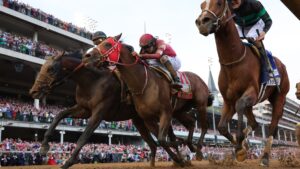The 151st Kentucky Derby: A Look at Equestrian Investments and Wealth Management
This Saturday, the excitement of the 151st Kentucky Derby unfolds at Churchill Downs, where the winner will claim an impressive $3.1 million from a purse of $5 million distributed among the top five finishers. As the thoroughbreds prepare to race, the event not only represents a rich tradition in American sports but also highlights an intriguing intersection between wealth management and the equestrian world.
The Wealth of Equestrian Investments
One familiar face at this year’s Derby will be Steven Mason, a private banker at Bank of America, who will be enjoying the race from the VIP finish line box alongside his high-net-worth clients. Based in Nashville, Tennessee, Mason has built a reputation as a specialist in equestrian clients, bringing insight and experience from his own upbringing in Kentucky.
Mason notes, “Horses are a lifestyle.” For many of his clients, owning a racehorse isn’t just about the thrill of competition—it’s a reflection of their identity and, in some cases, an investment opportunity. However, he cautions that equestrian assets can be remarkably illiquid, adding, “You have to look at it like there may be a return or there may not be, but I’m going to have a really good time while I’m pursuing wherever this goes.”
A Noteworthy Demographic Shift
Interestingly, while many of Mason’s clients grew up with an equestrian background, a rising wave of entrepreneurs are now entering the picture as first-time horse owners, particularly after lucrative liquidity events. The trend includes an influx of hedge fund managers, such as former hedge funder Jack Wolf, co-owner of the Triple Crown-winning horse, Justify.
Structuring Equestrian Assets
Mason’s clients often prefer financing their horse purchases through loans rather than liquidating assets and incurring capital gains taxes. While lenders like Bank of America are not open to accepting horses as collateral—an idea Mason characterizes as unappealing—they typically secure private credit lines with marketable securities.
With a prevailing interest rate that reflects the secured overnight financing rate (SOFR), currently averaging 4.35% plus a bank-determined spread, financing options for horse purchases are fluid, allowing clients to maintain a diversified investment portfolio while enjoying the thrill of horse ownership.
Earning Returns in Stud Fees
Often more lucrative than race earnings are the stud fees for successful racehorses, which can exceed $300,000 for top-tier horses. Many stallions breed 30 to 40 mares each season, creating a viable additional revenue stream for horse owners.
Despite the decline in overall popularity in horse racing, a robust demand persists for high-end racehorses, especially yearlings. For example, the Keeneland September yearling sale recently generated a record $428 million, with an average selling price of $150,548—up by 5.2% from the previous year. This trend illustrates a growing interest from investors and syndicates eager to enter the market.
The Cost of Care and Planning for the Future
Managing a thoroughbred is not without its expenses. Owners can expect to spend upwards of $60,000 a year on care. Mason advises clients concerned about the financial responsibilities of horse ownership to set up trusts designed to cover veterinary bills and ongoing costs, ensuring that their children are not left burdened by these expenses.
For Mason, fostering relationships with equestrian clients is more than a professional obligation; it’s a pathway to client loyalty. “When we can stand shoulder to shoulder with a client and talk with them about their particular situation, whether in our office, at a farm, or at a horse arena, it just makes that relationship all the more special and close-knit,” he concludes.
Final Thoughts
As we gear up for the excitement of the Derby, it’s essential to recognize the deeper investments and relationships that intertwine with horse racing. Whether you’re an aspiring owner or a seasoned investor, understanding the dynamics of equestrian assets can position you strategically in both the financial and social landscapes of this exhilarating industry.
Stay tuned for more insights and news that matter to investors like you at the Extreme Investor Network—where we bring you to the forefront of the investment landscape with a unique equestrian perspective.

